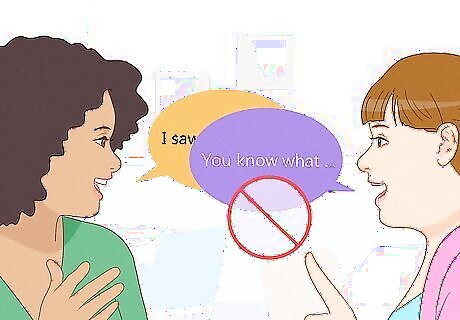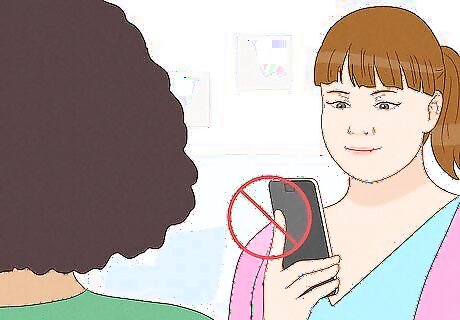
views
Face the person while they’re talking.

Turn your body towards the person so you shut out outside distractions. It might seem a little rude if you turn your back or shoulder to the person talking to you. Instead, sit or stand across from the person and face them directly so it’s easier to have a conversation. Maintain an open posture with your arms at your side rather than crossed in front of you, or else you might seem closed off.
Make eye contact.

You build stronger connections when you focus on the other person. Look the other person in the eyes so they know you’re paying attention to them. Try to focus on your conversation partner rather than getting distracted since they can easily see when you’re looking at the things happening around you. Break eye contact a few times while you’re talking so you aren’t staring at them for a long time. If you’re having trouble focusing, ask if you can continue the conversation somewhere that’s a little more quiet and private.
Lean in closer.

When you lean in, it seems like you’re trying to hear the person better. Try your best to avoid slouching or leaning back while someone’s talking since it might make you seem disinterested. Instead, try to get a bit closer to the person talking so they know that you’re listening. Just be sure to respect your conversation partner’s personal space so they don’t feel crowded or uneasy. If you know the person well, you could even reach over and lightly touch the person to connect with them more. Reader Poll: We asked 3954 wikiHow readers about the biggest tells that someone doesn’t want to talk to you, and only 6% said having a distant body position. [Take Poll] So, it can be okay to keep a little distance, but definitely smile and make eye contact so people know you’re interested in them!
Match their emotions.

Using the same facial expressions helps you empathize with someone. If the person is telling a fun story or having a casual conversation, smile along with them and raise your eyebrows to show your excitement. When they’re having a more serious discussion, it’s okay to frown or have a more neutral expression since it makes it seem like you’re deeper in thought.
Nod along to what they’re saying.

Nodding makes it look like you’re engaged and understanding. As the person’s telling you a story or explaining something to you, give them a couple of subtle nods so they know you’re following along. Nodding also helps encourage your conversation partner to keep talking because you’re interested in what they have to say.
Say brief acknowledgments in between their sentences.

Quick filler words can help encourage the person to talk more. As you’re nodding along, try saying things like “mmhmm” or “I see” to stay engaged. If the person says something shocking, react by saying “wow” or “really?” so they keep the conversation going. Even just adding in a few short reactions while you’re chatting can make it feel like you really care about the topic. Other things you might say include “Then what?” or “Oh my.”
Let them finish before talking.

Interrupting someone mid-thought makes it seem like you’re not listening. Avoid cutting into the conversation or changing the topic. Let the person fully explain and talk through the points they want to make. Do your best to focus on what the other person has to say rather than trying to think of how to respond. It’s okay if you need to take a few seconds after someone finishes talking to collect your thoughts since it shows that you’re really considering what they have to say.
Paraphrase what they tell you.

Repeat what the person says to make sure you understand them. When the person finishes talking, take a few seconds to collect your thoughts. Then, use your own words to summarize what they just said so they know that you were listening. Ask if you’re interpreting the conversation correctly so they have an opportunity to clarify or fill in any details that you missed. For example, you could say something like, “Let me make sure I understand this,” or, “Is that what you’re saying?” You could even frame your statement as a question. For example, if someone is talking about a promotion, you could say something like, “So how did you feel after you got the job offer?”
Ask follow-up questions.

Dig a little deeper so you seem genuinely curious on the topic. Use open-ended questions that start with “how,” “what,” or “why” since they require more than one word to answer. As you learn more about the topic, try to ask more specific questions to help you understand the topic and feel more involved. Your conversation partner will really appreciate that you’re trying to learn more and staying engaged with them. For example, you could ask something like, “What happened after that?” or “How did that make you feel?” Only ask 1 or 2 follow-up questions at a time that aren’t too personal.
Raise the tone and pitch of your voice.

You’ll seem more into the conversation if you sound expressive. Using a flat, monotone voice when you talk might make you sound bored, and that could really hurt your conversation partner’s feelings. Try raising the tone of your voice or speaking a little louder so you sound more passionate about the topic you’re discussing. Match the tone of your conversation topic. For example, if you’re having a more serious discussion, it’s okay if you use a lower tone. If you’re talking about a fun topic, use a more animated voice.
Avoid checking your phone or watch.

Look at the person you’re talking to instead of your phone or watch. Give the person you’re talking to your full, undivided attention so you can build a deeper connection. Put your phone down and do your best not to check the time since it could feel like you’re bored. Focus on what they’re saying so you clearly understand what they’re trying to say.
Keep an open mind.

When you judge someone, you won’t listen to what they have to say. Even if you don’t agree with what your conversation partner is talking about, try to view things from their point of view. Rather than falling back on a personal bias or assuming you know the whole story, focus on what the person is saying and how it makes them feel. It’s okay if you still disagree with the person once they finish talking, but still be respectful of their perspective.




















Comments
0 comment